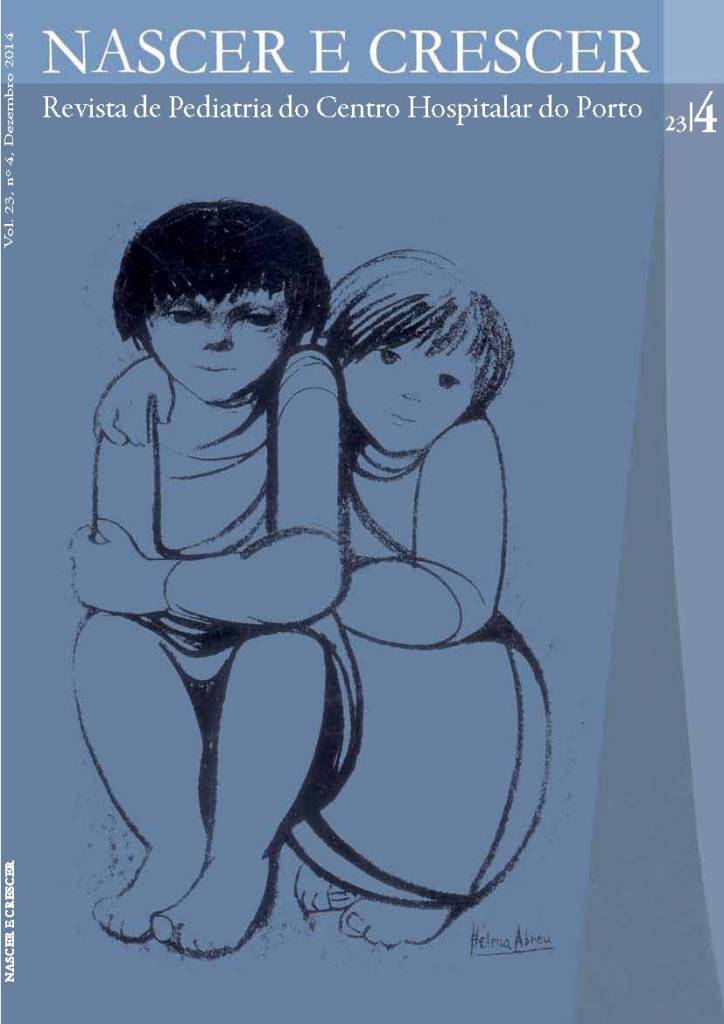Attention deficit and hyperactivity disorder: case series of a secondary center
DOI:
https://doi.org/10.25753/BirthGrowthMJ.v23.i4.8784Keywords:
Attention deficit disorder, behaviour disorder, hyperactivity, impulsivityAbstract
Introduction: Attention deficit and hyperactivity disorder (ADHD) is the most frequent neuro comportamental condition in age school children. The symptoms include difficulty in controlling physical activity, impulsivity and/or inattention.
Objective: To describe the characteristics of children with ADHD, in a second line hospital.
Material and methods: Retrospective study of children with ADHD. Variables included were: age, sex, personal and family medical history, symptoms, comorbid disorders, therapy and treatment outcome.
Results: The study included 45 children, 75,5% were male. At the time of diagnosis 62,2% of the children were between five and eight years. There was a family history related to ADHD in 40% of the patients. Learning disabilities and behaviour problems were the main causes for referral. Association of hyperactivity and attention deficit were found in 55,5% of the patients. The most frequent associated comorbid disorders were: learning disabilities, oppositional defi ant disorder, conduct disorder and anxiety. Medication with methylphenidate was started in 95% of the patients, 16,3% of them having adverse effects. The response to treatment showed favourable outcome in 80 %, with improvement in behaviour, school outcome and social interaction.
Conclusions: These fi ndings showed a high incidence of ADHD in boys between five and eight years. The association between attention defi cit and hyperactivity was the most common presentation. Learning disabilities and behaviour problems were the main causes for referral in this study. Intervention with a multidisciplinary and pharmacological approach showed favourable results.
Downloads
References
Committee on Quality Improvement, Subcommittee on Attention-Defi cit/Hyperactivity Disorder. Clinical practice guideline: diagnosis evaluation of the child with attention deficit/hyperactivity disorder. American Academy of Pediatrics. Pediatrics 2000; 105:1158-70.
Floet A M, Scheiner C, Grossman L. Attention-Deficit/ Hyperactivity Disorder. Pediatr Rev 2010; 31;56-69.
Krull K, Attention defi cit hyperactivity disorder in children and adolescents: Epidemiology and pathogenesis. Uptodate; (updated: january 2014, cited: january 2014). Available from: http://www.uptodate.com/contents/attentiondeficit-hyperactivity-disorder-in-children-and adolescentsepidemiology-and-pathogenesis.
Faraone SV, Doyle AE. The nature and heritability of attentiondeficit/ hyperactivity disorder. Child Adolesc Psychiatr Clin N Am 2001; 10:299-316.
Sergeant JA, Geurts H, Oosterlaan J. How specific is a deficit of executive functioning for attention defi cit/hyperactivity disorder? Behav Brain Res 2002; 130:3-28.
Mediavilla-García C. Neurobiología del trastorno de hiperactividad. Rev Neurol 2003; 36:555-65.
Castellanos FX, Tannochk R. Neuroscience of attention-defi cit/hyperactivity disorder: The search for endophenotypes. Nat Rev Neuroscience 2002; 3:617-28.
Cortese S. The neurobiology and genetics of Attention-Deficit/Hyperactivity Disorder (ADHD): what every clinician should know. J Paediatr Neurol 2012; 16:422-33.
Banerjee TD, Middleton F, Faraone SV. Environmental risk factors for attention-defi cit hyperactivity disorder. Acta Paediatr 2007; 96:1269-74.
Miranda A, Jarque S, Soriano M. Trastorno de hiperactividad con déficit de atención: polémicas actuales acerca de su definición, epidemiología, bases etiológicas y aproximaciones a la intervención. Rev Neurol. 1999; 28:182-8.
Polanczyk G, Jensen P. Epidemiologic considerations in attention defi cit hyperactivity disorder: a review and update. Child Adolesc Psychiatric Clin N Am 2008; 17:245-60.
Staller J, Faraone SV. Attention-Defi cit/Hyperactivity Disorder in girls: epidemiology and management. CNS Drugs 2006; 20:107-23.
Biederman J, Mick E, Faraone SV, Braaten E, Doyle A, Spencer T, et al. Infl uence of gender on attention deficit hyperactivity disorder in children referred to a psychiatric clinic. Am J Psychiatry 2002; 159:36-42.
Gershon JA. Meta-analytic review of gender differences in ADHD. J Atten Disord 2002; 5:143-54.
American Psychiatric Association. Attention-deficit/ hyperactivity disorder. In: Diagnostic and Statistical Manual of Mental Disorders. Fourth Edition Text Revision, American Psychiatric Association, Washington DC 2000.
Pliszka S, American Academy of Child and Adolescent Psychiatry WorkGroup on Quality Issues. Practice parameter for the assessment and treatment of children and adolescents with attention-efi cit/hyperactivity disorder. J Am Acad Child Adolesc Psychiatry 2007; 46:894-921.
Quality Improvement and Management Subcommittee on Attention-Defi cit/Hyperactivity Disorder, Steering Committee on of Attention-Defi cit/Hyperactivity Disorder in Children and Adolescents. ADHD: Clinical Practice Guideline for the Diagnosis, Evaluation, and Treatment. Pediatrics 2011; 128:1007-22.
Berger S. Cardiac evaluation of patients receiving pharmacotherapy for attention defi cit hyperactivity disorder. Uptodate, September 2013 (updated September 2013, cited: october 2013). Available from: http://www.uptodate.com/contents/cardiac-evaluation-of-patients-receivingpharmacotherapy-for-attention-deficit-hyperactivitydisorder.
Lalonde J, Turgay A, Hudson JI. Attention-deficit hyperactivity disorder subtypes and comorbid disruptive behaviour disorders in a child and adolescent mental health clinic. Can J Psychiatry 1998; 43:623.
Pliszka SR. Patterns of psychiatric comorbidity with attentiondeficit/hyperactivity disorder. Child Adolesc Psychiatr Clin N Am 2000; 9:525.
Subcommittee on Attention-Defi cit/Hyperactivity Disorder, Steering Committee on Quality Improvement and Management, Wolraich M, et al. ADHD: clinical practice guideline for the diagnosis, evaluation, and treatment of attention-defi cit/hyperactivity disorder in children and adolescents. Pediatrics 2011; 128:1007.
Larson K, Russ SA, Kahn RS, Halfon N. Patterns of comorbidity, functioning, and service use for US children with ADHD, 2007. Pediatrics 2011; 127:462.
Centers for Disease Control and Prevention (CDC). Increasing prevalence of parent-reported attention-defi cit/hyperactivity disorder among children - United States, 2003 and 2007. MMWR Morb Mortal Wkly Rep 2010; 59:1439.
Levy F, Hay DA, Bennett KS, McStephen M. Gender differences in ADHD subtype comorbidity. J Am Acad Child Adolesc Psychiatry 2005; 44:368.
MTA Cooperative Group. Multimodal Treatment Study of Children with ADHD. A 14-month andomized clinical trial of treatment strategies for attention-deficit/hyperactivity disorder. Arch Gen Psychiatry 1999; 56:1073-86.
Downloads
Published
How to Cite
Issue
Section
License
Copyright and access
This journal offers immediate free access to its content, following the principle that providing free scientific knowledge to the public provides greater global democratization of knowledge.
The works are licensed under a Creative Commons Attribution Non-commercial 4.0 International license.
Nascer e Crescer – Birth and Growth Medical Journal do not charge any submission or processing fee to the articles submitted.


